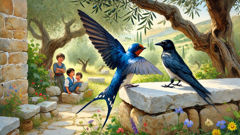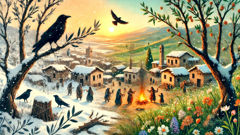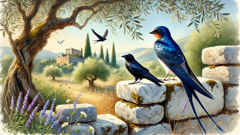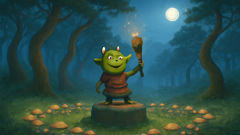Introduction
In the gentle embrace of ancient Greece, where the hills rolled like green waves and olive groves shimmered under the midday sun, countless creatures flourished among the thyme and wild poppies. This was a land shaped by myth and song, where the laughter of children blended with the humming of bees and the slow, rhythmic tolling of distant goat bells. Among the many birds that graced this countryside, none were more admired—or envied—than the swallow, whose sapphire feathers flashed as she darted above the fields. Swallows arrived with the spring, bringing hope and renewal, and their arrival was always met with delight. Yet, not all admired her beauty with kind hearts. In the shadow of the cypress trees lived a crow, his plumage dark as midnight, his eyes sharp and observant. The villagers said the crow was clever, for he could open walnut shells and find water where none seemed to flow. Children watched him hop from branch to branch, a silhouette against the sky, mysterious and steady. One warm afternoon, as the cicadas sang their endless song, the swallow and the crow found themselves perched on an ancient marble wall at the edge of the village. The wind carried the scent of honey and figs, and the olive trees whispered tales as old as the gods themselves. It was here, under the watchful gaze of the sun and the curious eyes of the village children, that the swallow and the crow began to argue—not about food, nor about territory, but about beauty. The swallow, proud of her shimmering blue feathers and delicate form, boasted that the gods themselves had painted her wings. The crow, unruffled and dignified, replied that wisdom and usefulness were worth more than the fleeting admiration of the eye. Their voices, sharp and musical, mingled with the soft rustle of the wind and the distant laughter of shepherds. As the day drew on, their words wove a story that would travel through the seasons—a story not just of beauty, but of endurance, ingenuity, and the wisdom that only hardship can bring. Beneath the Grecian sun, among wildflowers and ancient stones, the tale of the swallow and the crow began to unfold, promising lessons that would linger in the hearts of all who listened.
A Clash of Plumage and Pride
The midday sun poured its warmth over the village, turning the marble wall into a glowing perch. Children gathered nearby, drawn by the familiar chatter of the birds. The swallow flicked her tail, wings gleaming like sapphires, and called out in a voice that rang clear as a spring bell. “Tell me, crow, have you ever seen feathers as fine as mine? Each one is touched by the sky. When I sweep through the air, all eyes turn to watch. The gods themselves must have smiled when they made me.” Her words were laced with laughter, light as a breeze. The crow, with feathers as black as a moonless night, remained calm. He tilted his head, watching the swallow with a measured gaze. “You’re quick and lovely, little swallow,” he answered, “but what good is beauty if it cannot withstand the world? When winter comes and the wind bites, your bright feathers will do little to keep you safe.” The children listened, spellbound, as the two birds traded words. The swallow fluttered down to the grass, where the wildflowers bent in admiration. “Beauty brings joy,” she insisted. “When I return each spring, the people celebrate. They hang garlands in my honor and watch as I build my nest beneath their roofs. What joy do you bring with your dark wings and somber song?” The crow hopped to the edge of the wall, his black eyes reflecting the sunlight. “Not all joy is loud or bright. My feathers hide me from danger, and my mind finds food where others see none. I am welcome in every season—no storm drives me away. When winter strips the earth bare, I still find a way.” Their voices rose and fell like music through the olive groves. Some villagers stopped their work to listen, drawn by the unusual conversation. An old shepherd leaned on his staff, smiling at the ancient rivalry playing out anew. The swallow preened her feathers and sang a note so pure that even the breeze paused. “You speak of cleverness, but can cleverness make a heart soar? I bring hope with my return. My beauty is a gift to the world.” The crow ruffled his wings. “Hope must survive even in darkness. When beauty fades and hunger comes, what then?” The children’s faces turned thoughtful, for each bird’s words held a kind of truth. As the sun drifted lower and shadows lengthened across the fields, the air between swallow and crow shimmered with tension—a contest not just of feathers, but of spirit. In that quiet standoff, the seeds of understanding were sown, though neither bird realized it yet.

Seasons of Change: A Lesson in Hardship
As the days drifted onward, summer’s lushness gave way to autumn’s golden hush. The fields ripened, and the air grew heavy with the scent of ripe figs and fallen leaves. The swallow danced in the sky, darting above the vineyards and weaving through the orange groves. Her beauty was on full display as she caught insects on the wing, her flight graceful and swift. Meanwhile, the crow watched from a perch atop a fig tree. He noticed how the villagers admired the swallow—children ran after her shadow, elders tipped their hats as she swept overhead. Yet the crow also noticed something else: as the nights grew cooler, the swallow’s energy began to wane. The insects grew scarce, and her slender frame seemed to shiver in the chilly dusk. One afternoon, as the last sunbeams painted the village gold, the swallow met the crow by the well at the village square. Her wings drooped with exhaustion. “You look tired, friend,” the crow remarked gently. The swallow sighed. “The cold comes too quickly. My feathers—so beautiful in the sun—do little to keep me warm at night. Soon I must leave, fly far to where warmth endures.” The crow nodded. “I will stay. My coat keeps out the wind, and I know where to find food in every corner of this land. Even when frost grips the earth, I endure.” The swallow looked wistfully at the olive groves, at the children who waved as she passed. “I wish I could stay and be celebrated all year. But beauty alone cannot fight the cold.” The crow hopped closer, his tone softer than before. “It’s not weakness to leave. Every creature finds its way to survive. But remember—admiration is sweet, yet fleeting. When hardship comes, it’s wisdom and resourcefulness that carry us through.” The villagers watched as the swallow prepared for her journey. Some left crumbs on their windowsills, hoping to help her endure just a little longer. The crow remained a constant presence—quiet, unobtrusive, but always there when needed. He helped the children find lost trinkets in the grass and led thirsty goats to hidden streams. As autumn deepened and the first winds of winter began to howl through the olive branches, the swallow gathered with her kin. With one last look at the crow and the village she loved, she rose into the sky—her feathers a flash of blue against the gathering clouds.

Winter’s Wisdom and the Return of Spring
Winter arrived in Greece with a sudden force—sharp winds swept through the valleys, and frost painted silver patterns on every stone. The olive trees stood bare against a sky heavy with cloud, and the once-vibrant fields now lay under a shroud of quiet. In these months, the crow’s wisdom became his greatest ally. While other birds vanished or fell silent, he searched for food among the roots and stones, his dark form almost invisible in the gloom. He remembered every secret cache: nuts buried near the shepherd’s hut, seeds wedged between roof tiles, scraps left by the villagers on cold mornings. He watched over the village, calling warnings when a fox prowled or when a storm rolled in from the mountains. The children grew used to his presence—a silent sentinel in black, always there when needed but never demanding praise. Sometimes, at dusk, he would recall the swallow’s laughter and her radiant feathers. He wondered if she flew in sunlight somewhere far to the south, or if she missed the village that once celebrated her beauty. Time passed slowly. The villagers wrapped themselves in wool and told stories by the fire. They spoke of the swallow’s flight and the crow’s quiet courage, realizing that each bird had its season and its purpose. At last, the days grew longer, and a gentle warmth crept back into the air. Buds swelled on almond trees, wildflowers pushed through thawing soil, and hope returned to the countryside. On a bright morning in early spring, the villagers heard a familiar song—light, sweet, and full of promise. The swallow had returned. Her flight was less bold than before, her feathers a touch duller from her long journey, but her eyes shone with new understanding. She found the crow waiting by the marble wall, just as before. “You endured,” she said softly. “Through cold and hunger and darkness.” The crow nodded. “And you returned, carrying hope on your wings. Each of us has gifts—some seen, some hidden. Beauty fades; wisdom endures.” The children danced beneath the blossoming trees, welcoming both birds with joy. The swallow and the crow shared a quiet look—no longer rivals, but companions bound by the lessons of their journeys. The seasons would turn again, bringing hardship and joy, but their story would remain, whispered among olive leaves and sung by every wind that swept the Grecian hills.

Conclusion
In the land where marble gleamed beneath olive trees and legends blossomed like spring flowers, the tale of the swallow and the crow found its place in every heart. Their argument—sparked by pride and colored by longing—became a lesson whispered by grandmothers to children at twilight: true worth isn’t measured by what glitters in the sunlight but by what endures through life’s storms. The swallow’s beauty brought joy, but it was fleeting, tied to warm days and gentle skies. The crow’s wisdom kept him safe when winds howled and food was scarce. Over time, both birds understood that strength and resilience—quiet as a crow’s shadow or as brilliant as a swallow’s flight—were what mattered most. The villagers learned to admire not just what dazzled their eyes but what served them in hardship. And so, under ancient skies and among timeless stones, beauty and practicality found harmony at last. The olive groves still rustle with their story, carried by every breeze: when trouble comes, it’s not the brightest feathers but the keenest mind and stoutest heart that see us through.













